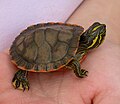| Alabama red-bellied cooter | |
|---|---|
 | |
| This turtle was sitting on the bank of Mobile Bay. | |
| Scientific classification | |
| Kingdom: | Animalia |
| Phylum: | Chordata |
| Class: | Reptilia |
| Order: | Testudines |
| Suborder: | Cryptodira |
| Family: | Emydidae |
| Genus: | Pseudemys |
| Species: | P. alabamensis |
| Binomial name | |
| Pseudemys alabamensis | |
 | |
| Alabama red-bellied cooter range [3] | |
| Synonyms [4] | |
| |
The Alabama red-bellied cooter (Pseudemys alabamensis) or Alabama red-bellied turtle, is native to Alabama. [1] [2] It belongs to the turtle family Emydidae, the pond turtles. It is the official reptile of the state of Alabama. [5]




